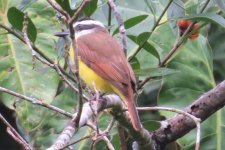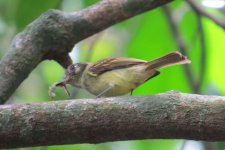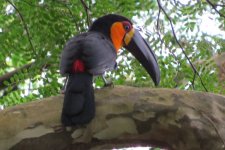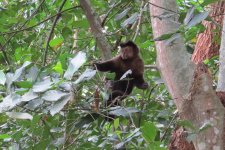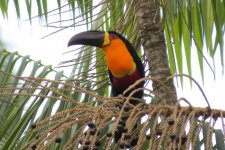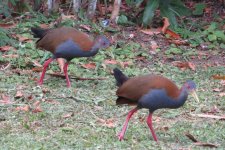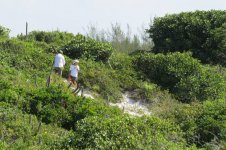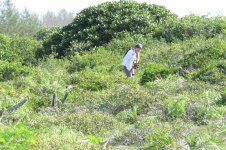Oregonian
Well-known member
My wife and I toured the state of Rio De Janero in the last two weeks of May, to look for birds and to photograph orchids in the wild. Her friends there have been inviting us to come, and it doesn't do to let such opportunities go by. Here is our itinerary:
May 18: arrive in Rio early, visit Tijuca NP
May 19: Parque Lage, Jardim Botanica
May 20: Successful day trip for Restinga Antwren, Arraial do Cabo
May 21: Paty do Alferes, for garden birding and visiting
May 22: Most of the day in Paty, traveling to Petropolis late afternoon.
May 23: Petro Preto - a private patch in Petropolis in the morning, driving to Nova Friburgo in the afternoon.
May 24 - 25: we stayed at a friend's country house in the area of Macaé de Cima in Tres Picos NP.
May 26 - 31: Reserva Ecológica de Guapiaçu (REGUA)
My intention is to write a little about each place, but sometimes I get distracted before finishing, so let me know if there is interest in a particular part.
Here's the list:
Solitary Tinamou (Tinamus solitarius)
White-faced Whistling-Duck (Dendrocygna viduata)
Black-bellied Whistling-Duck (Dendrocygna autumnalis)
Muscovy Duck (Cairina moschata)
Brazilian Teal (Amazonetta brasiliensis)
Rusty-margined Guan (Penelope superciliaris)
Dusky-legged Guan (Penelope obscura)
Pied-billed Grebe (Podilymbus podiceps)
Magnificent Frigatebird (Fregata magnificens)
Brown Booby (Sula leucogaster)
Neotropic Cormorant (Phalacrocorax brasilianus)
Anhinga (Anhinga anhinga)
Rufescent Tiger-Heron (Tigrisoma lineatum)
Cocoi Heron (Ardea cocoi)
Great Egret (Ardea alba)
Snowy Egret (Egretta thula)
Cattle Egret (Bubulcus ibis)
Striated Heron (Butorides striata)
Whistling Heron (Syrigma sibilatrix)
Capped Heron (Pilherodius pileatus)
Roseate Spoonbill (Platalea ajaja)
Black Vulture (Coragyps atratus)
Turkey Vulture (Cathartes aura)
Lesser Yellow-headed Vulture (Cathartes burrovianus)
Cathartes sp. (Cathartes sp.)
Savanna Hawk (Buteogallus meridionalis)
Roadside Hawk (Rupornis magnirostris)
White-tailed Hawk (Geranoaetus albicaudatus)
Mantled Hawk (Pseudastur polionotus)
Short-tailed Hawk (Buteo brachyurus)
Rufous-sided Crake (Laterallus melanophaius)
Slaty-breasted Wood-Rail (Aramides saracura)
Blackish Rail (Pardirallus nigricans)
Purple Gallinule (Porphyrio martinicus)
Common Gallinule (Gallinula galeata)
Black-necked Stilt (Himantopus mexicanus)
Southern Lapwing (Vanellus chilensis)
Wattled Jacana (Jacana jacana)
South American Snipe (Gallinago paraguaiae)
Giant Snipe (Gallinago undulata)
Kelp Gull (Larus dominicanus)
Rock Pigeon (Columba livia)
Pale-vented Pigeon (Patagioenas cayennensis)
Picazuro Pigeon (Patagioenas picazuro)
Ruddy Pigeon (Patagioenas subvinacea)
Ruddy Ground-Dove (Columbina talpacoti)
White-tipped Dove (Leptotila verreauxi)
Gray-fronted Dove (Leptotila rufaxilla)
Squirrel Cuckoo (Piaya cayana)
Guira Cuckoo (Guira guira)
Greater Ani (Crotophaga major)
Smooth-billed Ani (Crotophaga ani)
Ferruginous Pygmy-Owl (Glaucidium brasilianum)
Burrowing Owl (Athene cunicularia)
Common Pauraque (Nyctidromus albicollis)
Long-tailed Potoo (Nyctibius aethereus)
White-collared Swift (Streptoprocne zonaris)
Lesser Swallow-tailed Swift (Panyptila cayennensis)
Saw-billed Hermit (Ramphodon naevius)
Rufous-breasted Hermit (Glaucis hirsutus)
Planalto Hermit (Phaethornis pretrei)
Glittering-bellied Emerald (Chlorostilbon lucidus)
Plovercrest (Stephanoxis lalandi)
Swallow-tailed Hummingbird (Eupetomena macroura)
Violet-capped Woodnymph (Thalurania glaucopis)
Sombre Hummingbird (Aphantochroa cirrochloris)
Glittering-throated Emerald (Amazilia fimbriata)
Surucua Trogon (Trogon surrucura)
Black-throated Trogon (Trogon rufus)
Rufous-capped Motmot (Baryphthengus ruficapillus)
Ringed Kingfisher (Megaceryle torquata)
Amazon Kingfisher (Chloroceryle amazona)
Green-and-rufous Kingfisher (Chloroceryle inda)
White-eared Puffbird (Nystalus chacuru)
Crescent-chested Puffbird (Malacoptila striata)
Rufous-tailed Jacamar (Galbula ruficauda)
Saffron Toucanet (Pteroglossus bailloni)
Spot-billed Toucanet (Selenidera maculirostris)
Toco Toucan (Ramphastos toco)
Channel-billed Toucan (Ramphastos vitellinus)
White-barred Piculet (Picumnus cirratus)
White Woodpecker (Melanerpes candidus)
Yellow-fronted Woodpecker (Melanerpes flavifrons)
Yellow-eared Woodpecker (Veniliornis maculifrons)
White-browed Woodpecker (Piculus aurulentus)
Campo Flicker (Colaptes campestris)
Blond-crested Woodpecker (Celeus flavescens)
Red-legged Seriema (Cariama cristata)
Collared Forest-Falcon (Micrastur semitorquatus)
Southern Caracara (Caracara plancus)
Yellow-headed Caracara (Milvago chimachima)
Laughing Falcon (Herpetotheres cachinnans)
Aplomado Falcon (Falco femoralis)
Maroon-bellied Parakeet (Pyrrhura frontalis)
White-eyed Parakeet (Aratinga leucophthalma)
Blue-winged Macaw (Primolius maracana)
Blue-winged Parrotlet (Forpus xanthopterygius)
Plain Parakeet (Brotogeris tirica)
Spot-backed Antshrike (Hypoedaleus guttatus)
White-bearded Antshrike (Biatas nigropectus)
Chestnut-backed Antshrike (Thamnophilus palliatus)
Sooretama Slaty-Antshrike (Thamnophilus ambiguus)
Variable Antshrike (Thamnophilus caerulescens)
Star-throated Antwren (Rhopias gularis)
Plain Antvireo (Dysithamnus mentalis)
White-flanked Antwren (Myrmotherula axillaris)
Salvadori's Antwren (Myrmotherula minor)
Unicolored Antwren (Myrmotherula unicolor)
Restinga Antwren (Formicivora littoralis)
Ferruginous Antbird (Drymophila ferruginea)
Ochre-rumped Antbird (Drymophila ochropyga)
Scaled Antbird (Drymophila squamata)
Streak-capped Antwren (Terenura maculata)
White-shouldered Fire-eye (Pyriglena leucoptera)
Black-cheeked Gnateater (Conopophaga melanops)
Slaty Bristlefront (Merulaxis ater)
Mouse-colored Tapaculo (Scytalopus speluncae)
Rufous-capped Antthrush (Formicarius colma)
Rufous-breasted Leaftosser (Sclerurus scansor)
Olivaceous Woodcreeper (Sittasomus griseicapillus)
Plain-winged Woodcreeper (Dendrocincla turdina)
Lesser Woodcreeper (Xiphorhynchus fuscus)
Black-billed Scythebill (Campylorhamphus falcularius)
Scaled Woodcreeper (Lepidocolaptes squamatus)
Plain Xenops (Xenops minutus)
Streaked Xenops (Xenops rutilans)
Wing-banded Hornero (Furnarius figulus)
Rufous Hornero (Furnarius rufus)
Pale-browed Treehunter (Cichlocolaptes leucophrus)
Black-capped Foliage-gleaner (Philydor atricapillus)
Buff-fronted Foliage-gleaner (Philydor rufum)
Ochre-breasted Foliage-gleaner (Anabacerthia lichtensteini)
White-eyed Foliage-gleaner (Automolus leucophthalmus)
Yellow-chinned Spinetail (Certhiaxis cinnamomeus)
Southern Beardless-Tyrannulet (Camptostoma obsoletum)
Yellow Tyrannulet (Capsiempis flaveola)
Ochre-bellied Flycatcher (Mionectes oleagineus)
Gray-hooded Flycatcher (Mionectes rufiventris)
Sepia-capped Flycatcher (Leptopogon amaurocephalus)
Mottle-cheeked Tyrannulet (Phylloscartes ventralis)
Oustalet's Tyrannulet (Phylloscartes oustaleti)
Planalto Tyrannulet (Phyllomyias fasciatus)
Southern Antpipit (Corythopis delalandi)
Eye-ringed Tody-Tyrant (Hemitriccus orbitatus)
Hangnest Tody-Tyrant (Hemitriccus nidipendulus)
Gray-headed Tody-Flycatcher (Todirostrum poliocephalum)
Common Tody-Flycatcher (Todirostrum cinereum)
Yellow-olive Flycatcher (Tolmomyias sulphurescens)
White-throated Spadebill (Platyrinchus mystaceus)
Cliff Flycatcher (Hirundinea ferruginea)
Whiskered Flycatcher (Myiobius barbatus)
Bran-colored Flycatcher (Myiophobus fasciatus)
Euler's Flycatcher (Lathrotriccus euleri)
Tropical Pewee (Contopus cinereus)
Fuscous Flycatcher (Cnemotriccus fuscatus)
Velvety Black-Tyrant (Knipolegus nigerrimus)
Yellow-browed Tyrant (Satrapa icterophrys)
Shear-tailed Gray Tyrant (Muscipipra vetula)
Masked Water-Tyrant (Fluvicola nengeta)
White-headed Marsh Tyrant (Arundinicola leucocephala)
Long-tailed Tyrant (Colonia colonus)
Cattle Tyrant (Machetornis rixosa)
Large-headed Flatbill (Ramphotrigon megacephalum)
Gray-hooded Attila (Attila rufus)
Sirystes (Sirystes sibilator)
Grayish Mourner (Rhytipterna simplex)
Dusky-capped Flycatcher (Myiarchus tuberculifer)
Short-crested Flycatcher (Myiarchus ferox)
Great Kiskadee (Pitangus sulphuratus)
Boat-billed Flycatcher (Megarynchus pitangua)
Rusty-margined Flycatcher (Myiozetetes cayanensis)
Social Flycatcher (Myiozetetes similis)
Tropical Kingbird (Tyrannus melancholicus)
Sharpbill (Oxyruncus cristatus)
Bare-throated Bellbird (Procnias nudicollis)
Pin-tailed Manakin (Ilicura militaris)
Swallow-tailed Manakin (Chiroxiphia caudata)
White-bearded Manakin (Manacus manacus)
Greenish Schiffornis (Schiffornis virescens)
Shrike-like Cotinga (Laniisoma elegans)
Green-backed Becard (Pachyramphus viridis)
Chestnut-crowned Becard (Pachyramphus castaneus)
Black-capped Becard (Pachyramphus marginatus)
Crested Becard (Pachyramphus validus)
Red-eyed Vireo (Vireo olivaceus)
Lemon-chested Greenlet (Hylophilus thoracicus)
Rufous-browed Peppershrike (Cyclarhis gujanensis)
Curl-crested Jay (Cyanocorax cristatellus)
Blue-and-white Swallow (Pygochelidon cyanoleuca)
White-thighed Swallow (Atticora tibialis)
Southern Rough-winged Swallow (Stelgidopteryx ruficollis)
Gray-breasted Martin (Progne chalybea)
House Wren (Troglodytes aedon)
Moustached Wren (Pheugopedius genibarbis)
Long-billed Wren (Cantorchilus longirostris)
Black-capped Donacobius (Donacobius atricapilla)
Pale-breasted Thrush (Turdus leucomelas)
Rufous-bellied Thrush (Turdus rufiventris)
Creamy-bellied Thrush (Turdus amaurochalinus)
White-necked Thrush (Turdus albicollis)
Turdus sp. (Turdus sp.)
Chalk-browed Mockingbird (Mimus saturninus)
Tropical Mockingbird (Mimus gilvus)
Tropical Parula (Setophaga pitiayumi)
Golden-crowned Warbler (Basileuterus culicivorus)
Riverbank Warbler (Myiothlypis rivularis)
Hooded Tanager (Nemosia pileata)
Olive-green Tanager (Orthogonys chloricterus)
Black-goggled Tanager (Trichothraupis melanops)
Flame-crested Tanager (Tachyphonus cristatus)
Ruby-crowned Tanager (Tachyphonus coronatus)
Brazilian Tanager (Ramphocelus bresilius)
Fawn-breasted Tanager (Pipraeidea melanonota)
Sayaca Tanager (Thraupis sayaca)
Azure-shouldered Tanager (Thraupis cyanoptera)
Golden-chevroned Tanager (Thraupis ornata)
Palm Tanager (Thraupis palmarum)
Burnished-buff Tanager (Tangara cayana)
Green-headed Tanager (Tangara seledon)
Red-necked Tanager (Tangara cyanocephala)
Brassy-breasted Tanager (Tangara desmaresti)
Black-legged Dacnis (Dacnis nigripes)
Blue Dacnis (Dacnis cayana)
Rufous-headed Tanager (Hemithraupis ruficapilla)
Yellow-backed Tanager (Hemithraupis flavicollis)
Chestnut-vented Conebill (Conirostrum speciosum)
Saffron Finch (Sicalis flaveola)
Bananaquit (Coereba flaveola)
Green-winged Saltator (Saltator similis)
Black-throated Grosbeak (Saltator fuliginosus)
Rufous-collared Sparrow (Zonotrichia capensis)
Red-crowned Ant-Tanager (Habia rubica)
Yellow-green Grosbeak (Caryothraustes canadensis)
Red-rumped Cacique (Cacicus haemorrhous)
Crested Oropendola (Psarocolius decumanus)
Purple-throated Euphonia (Euphonia chlorotica)
Violaceous Euphonia (Euphonia violacea)
Orange-bellied Euphonia (Euphonia xanthogaster)
Chestnut-bellied Euphonia (Euphonia pectoralis)
House Sparrow (Passer domesticus)
Common Waxbill (Estrilda astrild)
May 18: arrive in Rio early, visit Tijuca NP
May 19: Parque Lage, Jardim Botanica
May 20: Successful day trip for Restinga Antwren, Arraial do Cabo
May 21: Paty do Alferes, for garden birding and visiting
May 22: Most of the day in Paty, traveling to Petropolis late afternoon.
May 23: Petro Preto - a private patch in Petropolis in the morning, driving to Nova Friburgo in the afternoon.
May 24 - 25: we stayed at a friend's country house in the area of Macaé de Cima in Tres Picos NP.
May 26 - 31: Reserva Ecológica de Guapiaçu (REGUA)
My intention is to write a little about each place, but sometimes I get distracted before finishing, so let me know if there is interest in a particular part.
Here's the list:
Solitary Tinamou (Tinamus solitarius)
White-faced Whistling-Duck (Dendrocygna viduata)
Black-bellied Whistling-Duck (Dendrocygna autumnalis)
Muscovy Duck (Cairina moschata)
Brazilian Teal (Amazonetta brasiliensis)
Rusty-margined Guan (Penelope superciliaris)
Dusky-legged Guan (Penelope obscura)
Pied-billed Grebe (Podilymbus podiceps)
Magnificent Frigatebird (Fregata magnificens)
Brown Booby (Sula leucogaster)
Neotropic Cormorant (Phalacrocorax brasilianus)
Anhinga (Anhinga anhinga)
Rufescent Tiger-Heron (Tigrisoma lineatum)
Cocoi Heron (Ardea cocoi)
Great Egret (Ardea alba)
Snowy Egret (Egretta thula)
Cattle Egret (Bubulcus ibis)
Striated Heron (Butorides striata)
Whistling Heron (Syrigma sibilatrix)
Capped Heron (Pilherodius pileatus)
Roseate Spoonbill (Platalea ajaja)
Black Vulture (Coragyps atratus)
Turkey Vulture (Cathartes aura)
Lesser Yellow-headed Vulture (Cathartes burrovianus)
Cathartes sp. (Cathartes sp.)
Savanna Hawk (Buteogallus meridionalis)
Roadside Hawk (Rupornis magnirostris)
White-tailed Hawk (Geranoaetus albicaudatus)
Mantled Hawk (Pseudastur polionotus)
Short-tailed Hawk (Buteo brachyurus)
Rufous-sided Crake (Laterallus melanophaius)
Slaty-breasted Wood-Rail (Aramides saracura)
Blackish Rail (Pardirallus nigricans)
Purple Gallinule (Porphyrio martinicus)
Common Gallinule (Gallinula galeata)
Black-necked Stilt (Himantopus mexicanus)
Southern Lapwing (Vanellus chilensis)
Wattled Jacana (Jacana jacana)
South American Snipe (Gallinago paraguaiae)
Giant Snipe (Gallinago undulata)
Kelp Gull (Larus dominicanus)
Rock Pigeon (Columba livia)
Pale-vented Pigeon (Patagioenas cayennensis)
Picazuro Pigeon (Patagioenas picazuro)
Ruddy Pigeon (Patagioenas subvinacea)
Ruddy Ground-Dove (Columbina talpacoti)
White-tipped Dove (Leptotila verreauxi)
Gray-fronted Dove (Leptotila rufaxilla)
Squirrel Cuckoo (Piaya cayana)
Guira Cuckoo (Guira guira)
Greater Ani (Crotophaga major)
Smooth-billed Ani (Crotophaga ani)
Ferruginous Pygmy-Owl (Glaucidium brasilianum)
Burrowing Owl (Athene cunicularia)
Common Pauraque (Nyctidromus albicollis)
Long-tailed Potoo (Nyctibius aethereus)
White-collared Swift (Streptoprocne zonaris)
Lesser Swallow-tailed Swift (Panyptila cayennensis)
Saw-billed Hermit (Ramphodon naevius)
Rufous-breasted Hermit (Glaucis hirsutus)
Planalto Hermit (Phaethornis pretrei)
Glittering-bellied Emerald (Chlorostilbon lucidus)
Plovercrest (Stephanoxis lalandi)
Swallow-tailed Hummingbird (Eupetomena macroura)
Violet-capped Woodnymph (Thalurania glaucopis)
Sombre Hummingbird (Aphantochroa cirrochloris)
Glittering-throated Emerald (Amazilia fimbriata)
Surucua Trogon (Trogon surrucura)
Black-throated Trogon (Trogon rufus)
Rufous-capped Motmot (Baryphthengus ruficapillus)
Ringed Kingfisher (Megaceryle torquata)
Amazon Kingfisher (Chloroceryle amazona)
Green-and-rufous Kingfisher (Chloroceryle inda)
White-eared Puffbird (Nystalus chacuru)
Crescent-chested Puffbird (Malacoptila striata)
Rufous-tailed Jacamar (Galbula ruficauda)
Saffron Toucanet (Pteroglossus bailloni)
Spot-billed Toucanet (Selenidera maculirostris)
Toco Toucan (Ramphastos toco)
Channel-billed Toucan (Ramphastos vitellinus)
White-barred Piculet (Picumnus cirratus)
White Woodpecker (Melanerpes candidus)
Yellow-fronted Woodpecker (Melanerpes flavifrons)
Yellow-eared Woodpecker (Veniliornis maculifrons)
White-browed Woodpecker (Piculus aurulentus)
Campo Flicker (Colaptes campestris)
Blond-crested Woodpecker (Celeus flavescens)
Red-legged Seriema (Cariama cristata)
Collared Forest-Falcon (Micrastur semitorquatus)
Southern Caracara (Caracara plancus)
Yellow-headed Caracara (Milvago chimachima)
Laughing Falcon (Herpetotheres cachinnans)
Aplomado Falcon (Falco femoralis)
Maroon-bellied Parakeet (Pyrrhura frontalis)
White-eyed Parakeet (Aratinga leucophthalma)
Blue-winged Macaw (Primolius maracana)
Blue-winged Parrotlet (Forpus xanthopterygius)
Plain Parakeet (Brotogeris tirica)
Spot-backed Antshrike (Hypoedaleus guttatus)
White-bearded Antshrike (Biatas nigropectus)
Chestnut-backed Antshrike (Thamnophilus palliatus)
Sooretama Slaty-Antshrike (Thamnophilus ambiguus)
Variable Antshrike (Thamnophilus caerulescens)
Star-throated Antwren (Rhopias gularis)
Plain Antvireo (Dysithamnus mentalis)
White-flanked Antwren (Myrmotherula axillaris)
Salvadori's Antwren (Myrmotherula minor)
Unicolored Antwren (Myrmotherula unicolor)
Restinga Antwren (Formicivora littoralis)
Ferruginous Antbird (Drymophila ferruginea)
Ochre-rumped Antbird (Drymophila ochropyga)
Scaled Antbird (Drymophila squamata)
Streak-capped Antwren (Terenura maculata)
White-shouldered Fire-eye (Pyriglena leucoptera)
Black-cheeked Gnateater (Conopophaga melanops)
Slaty Bristlefront (Merulaxis ater)
Mouse-colored Tapaculo (Scytalopus speluncae)
Rufous-capped Antthrush (Formicarius colma)
Rufous-breasted Leaftosser (Sclerurus scansor)
Olivaceous Woodcreeper (Sittasomus griseicapillus)
Plain-winged Woodcreeper (Dendrocincla turdina)
Lesser Woodcreeper (Xiphorhynchus fuscus)
Black-billed Scythebill (Campylorhamphus falcularius)
Scaled Woodcreeper (Lepidocolaptes squamatus)
Plain Xenops (Xenops minutus)
Streaked Xenops (Xenops rutilans)
Wing-banded Hornero (Furnarius figulus)
Rufous Hornero (Furnarius rufus)
Pale-browed Treehunter (Cichlocolaptes leucophrus)
Black-capped Foliage-gleaner (Philydor atricapillus)
Buff-fronted Foliage-gleaner (Philydor rufum)
Ochre-breasted Foliage-gleaner (Anabacerthia lichtensteini)
White-eyed Foliage-gleaner (Automolus leucophthalmus)
Yellow-chinned Spinetail (Certhiaxis cinnamomeus)
Southern Beardless-Tyrannulet (Camptostoma obsoletum)
Yellow Tyrannulet (Capsiempis flaveola)
Ochre-bellied Flycatcher (Mionectes oleagineus)
Gray-hooded Flycatcher (Mionectes rufiventris)
Sepia-capped Flycatcher (Leptopogon amaurocephalus)
Mottle-cheeked Tyrannulet (Phylloscartes ventralis)
Oustalet's Tyrannulet (Phylloscartes oustaleti)
Planalto Tyrannulet (Phyllomyias fasciatus)
Southern Antpipit (Corythopis delalandi)
Eye-ringed Tody-Tyrant (Hemitriccus orbitatus)
Hangnest Tody-Tyrant (Hemitriccus nidipendulus)
Gray-headed Tody-Flycatcher (Todirostrum poliocephalum)
Common Tody-Flycatcher (Todirostrum cinereum)
Yellow-olive Flycatcher (Tolmomyias sulphurescens)
White-throated Spadebill (Platyrinchus mystaceus)
Cliff Flycatcher (Hirundinea ferruginea)
Whiskered Flycatcher (Myiobius barbatus)
Bran-colored Flycatcher (Myiophobus fasciatus)
Euler's Flycatcher (Lathrotriccus euleri)
Tropical Pewee (Contopus cinereus)
Fuscous Flycatcher (Cnemotriccus fuscatus)
Velvety Black-Tyrant (Knipolegus nigerrimus)
Yellow-browed Tyrant (Satrapa icterophrys)
Shear-tailed Gray Tyrant (Muscipipra vetula)
Masked Water-Tyrant (Fluvicola nengeta)
White-headed Marsh Tyrant (Arundinicola leucocephala)
Long-tailed Tyrant (Colonia colonus)
Cattle Tyrant (Machetornis rixosa)
Large-headed Flatbill (Ramphotrigon megacephalum)
Gray-hooded Attila (Attila rufus)
Sirystes (Sirystes sibilator)
Grayish Mourner (Rhytipterna simplex)
Dusky-capped Flycatcher (Myiarchus tuberculifer)
Short-crested Flycatcher (Myiarchus ferox)
Great Kiskadee (Pitangus sulphuratus)
Boat-billed Flycatcher (Megarynchus pitangua)
Rusty-margined Flycatcher (Myiozetetes cayanensis)
Social Flycatcher (Myiozetetes similis)
Tropical Kingbird (Tyrannus melancholicus)
Sharpbill (Oxyruncus cristatus)
Bare-throated Bellbird (Procnias nudicollis)
Pin-tailed Manakin (Ilicura militaris)
Swallow-tailed Manakin (Chiroxiphia caudata)
White-bearded Manakin (Manacus manacus)
Greenish Schiffornis (Schiffornis virescens)
Shrike-like Cotinga (Laniisoma elegans)
Green-backed Becard (Pachyramphus viridis)
Chestnut-crowned Becard (Pachyramphus castaneus)
Black-capped Becard (Pachyramphus marginatus)
Crested Becard (Pachyramphus validus)
Red-eyed Vireo (Vireo olivaceus)
Lemon-chested Greenlet (Hylophilus thoracicus)
Rufous-browed Peppershrike (Cyclarhis gujanensis)
Curl-crested Jay (Cyanocorax cristatellus)
Blue-and-white Swallow (Pygochelidon cyanoleuca)
White-thighed Swallow (Atticora tibialis)
Southern Rough-winged Swallow (Stelgidopteryx ruficollis)
Gray-breasted Martin (Progne chalybea)
House Wren (Troglodytes aedon)
Moustached Wren (Pheugopedius genibarbis)
Long-billed Wren (Cantorchilus longirostris)
Black-capped Donacobius (Donacobius atricapilla)
Pale-breasted Thrush (Turdus leucomelas)
Rufous-bellied Thrush (Turdus rufiventris)
Creamy-bellied Thrush (Turdus amaurochalinus)
White-necked Thrush (Turdus albicollis)
Turdus sp. (Turdus sp.)
Chalk-browed Mockingbird (Mimus saturninus)
Tropical Mockingbird (Mimus gilvus)
Tropical Parula (Setophaga pitiayumi)
Golden-crowned Warbler (Basileuterus culicivorus)
Riverbank Warbler (Myiothlypis rivularis)
Hooded Tanager (Nemosia pileata)
Olive-green Tanager (Orthogonys chloricterus)
Black-goggled Tanager (Trichothraupis melanops)
Flame-crested Tanager (Tachyphonus cristatus)
Ruby-crowned Tanager (Tachyphonus coronatus)
Brazilian Tanager (Ramphocelus bresilius)
Fawn-breasted Tanager (Pipraeidea melanonota)
Sayaca Tanager (Thraupis sayaca)
Azure-shouldered Tanager (Thraupis cyanoptera)
Golden-chevroned Tanager (Thraupis ornata)
Palm Tanager (Thraupis palmarum)
Burnished-buff Tanager (Tangara cayana)
Green-headed Tanager (Tangara seledon)
Red-necked Tanager (Tangara cyanocephala)
Brassy-breasted Tanager (Tangara desmaresti)
Black-legged Dacnis (Dacnis nigripes)
Blue Dacnis (Dacnis cayana)
Rufous-headed Tanager (Hemithraupis ruficapilla)
Yellow-backed Tanager (Hemithraupis flavicollis)
Chestnut-vented Conebill (Conirostrum speciosum)
Saffron Finch (Sicalis flaveola)
Bananaquit (Coereba flaveola)
Green-winged Saltator (Saltator similis)
Black-throated Grosbeak (Saltator fuliginosus)
Rufous-collared Sparrow (Zonotrichia capensis)
Red-crowned Ant-Tanager (Habia rubica)
Yellow-green Grosbeak (Caryothraustes canadensis)
Red-rumped Cacique (Cacicus haemorrhous)
Crested Oropendola (Psarocolius decumanus)
Purple-throated Euphonia (Euphonia chlorotica)
Violaceous Euphonia (Euphonia violacea)
Orange-bellied Euphonia (Euphonia xanthogaster)
Chestnut-bellied Euphonia (Euphonia pectoralis)
House Sparrow (Passer domesticus)
Common Waxbill (Estrilda astrild)




